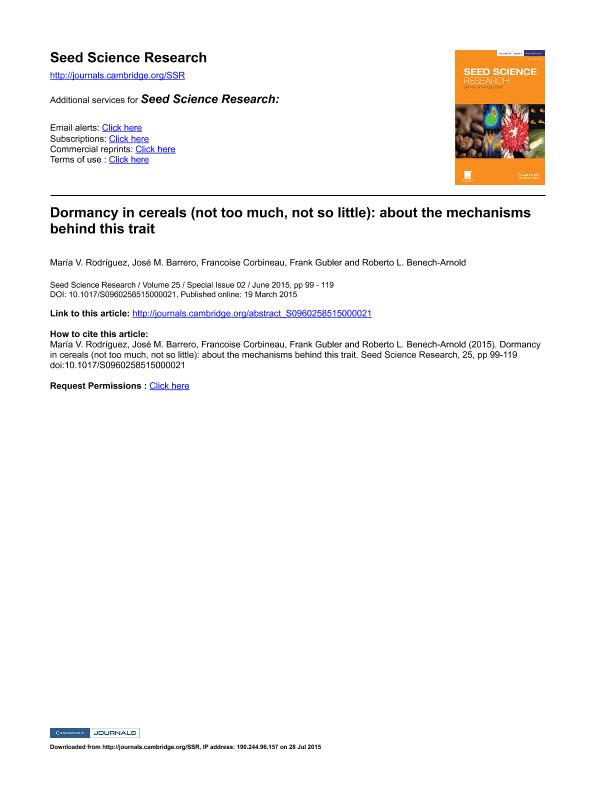Mostrar el registro sencillo del ítem
dc.contributor.author
Rodríguez, María Verónica

dc.contributor.author
Barrero, J. M.
dc.contributor.author
Corbineau, Francoise
dc.contributor.author
Gubler, Frank
dc.contributor.author
Benech-arnold, Roberto Luis

dc.date.available
2016-02-22T12:41:58Z
dc.date.issued
2015-06
dc.identifier.citation
Rodríguez, María Verónica; Barrero, J. M.; Corbineau, Francoise; Gubler, Frank; Benech-arnold, Roberto Luis; Dormancy in cereals (not too much, not so little): about the mechanisms behind this trait; Cambridge University Press; Seed Science Research; 25; 02; 6-2015; 99-119
dc.identifier.issn
0960-2585
dc.identifier.uri
http://hdl.handle.net/11336/4336
dc.description.abstract
As in other cultivated species, dormancy can be seen as a problem in cereal production, either due to its short duration or to its long persistence. Indeed, cereal crops lacking enough dormancy at harvest can be exposed to pre-harvest sprouting damage, while a long-lasting dormancy can interfere with processes that rely on rapid germination, such as malting or the emergence of a uniform crop. Because the ancestors of cereal species evolved under very diverse environments worldwide, different mechanisms have arisen as a way of sensing an appropriate germination environment (a crucial factor for winter or summer annuals such as cereals). In addition, different species (and even different varieties within the same species) display diverse grain morphology, allowing some structures to impose dormancy in some cereals but not in others. As in seeds from many other species, the antagonism between the plant hormones abscisic acid and gibberellins is instrumental in cereal grains for the inception, expression, release and re-induction of dormancy. However, the way in which this antagonism operates is different for the various species and involves different molecular steps as regulatory sites. Environmental signals (i.e. temperature, light quality and quantity, oxygen levels) can modulate this hormonal control of dormancy differently, depending on the species. The practical implications of knowledge accumulated in this field are discussed.
dc.format
application/pdf
dc.language.iso
eng
dc.publisher
Cambridge University Press

dc.rights
info:eu-repo/semantics/openAccess
dc.rights.uri
https://creativecommons.org/licenses/by-nc-sa/2.5/ar/
dc.subject
Cereals
dc.subject
Dormancy
dc.subject
Pre-Harvest Sproutinng
dc.subject.classification
Agronomía, reproducción y protección de plantas

dc.subject.classification
Agricultura, Silvicultura y Pesca

dc.subject.classification
CIENCIAS AGRÍCOLAS

dc.title
Dormancy in cereals (not too much, not so little): about the mechanisms behind this trait
dc.type
info:eu-repo/semantics/article
dc.type
info:ar-repo/semantics/artículo
dc.type
info:eu-repo/semantics/publishedVersion
dc.date.updated
2016-03-30 10:35:44.97925-03
dc.journal.volume
25
dc.journal.number
02
dc.journal.pagination
99-119
dc.journal.pais
Reino Unido

dc.journal.ciudad
Cambridge
dc.description.fil
Fil: Rodríguez, María Verónica. Consejo Nacional de Investigaciones Científicas y Técnicas. Oficina de Coordinación Administrativa Parque Centenario. Instituto de Investigaciones Fisiológicas y Ecológicas Vinculadas A la Agricultura; Argentina
dc.description.fil
Fil: Barrero, J. M.. CSIRO Agriculture Flagship; Australia
dc.description.fil
Fil: Corbineau, Francoise. Universite Pierre et Marie Curie; Francia
dc.description.fil
Fil: Gubler, Frank. CSIRO Agriculture Flagship; Australia
dc.description.fil
Fil: Benech-arnold, Roberto Luis. Consejo Nacional de Investigaciones Científicas y Técnicas. Oficina de Coordinación Administrativa Parque Centenario. Instituto de Investigaciones Fisiológicas y Ecológicas Vinculadas A la Agricultura; Argentina
dc.journal.title
Seed Science Research

dc.relation.alternativeid
info:eu-repo/semantics/altIdentifier/url/http://journals.cambridge.org/action/displayAbstract?fromPage=online&aid=9747395&fileId=S0960258515000021
dc.relation.alternativeid
info:eu-repo/semantics/altIdentifier/doi/http://dx.doi.org/10.1017/S0960258515000021
dc.relation.alternativeid
info:eu-repo/semantics/altIdentifier/issn/0960-2585
Archivos asociados
